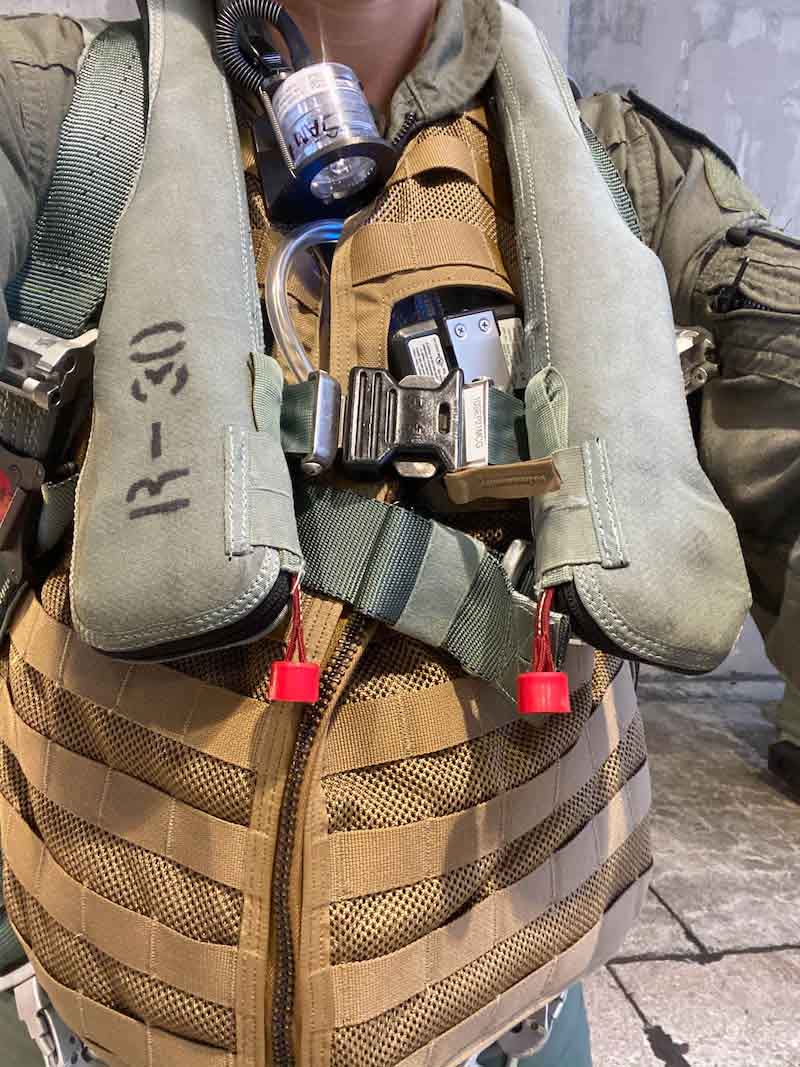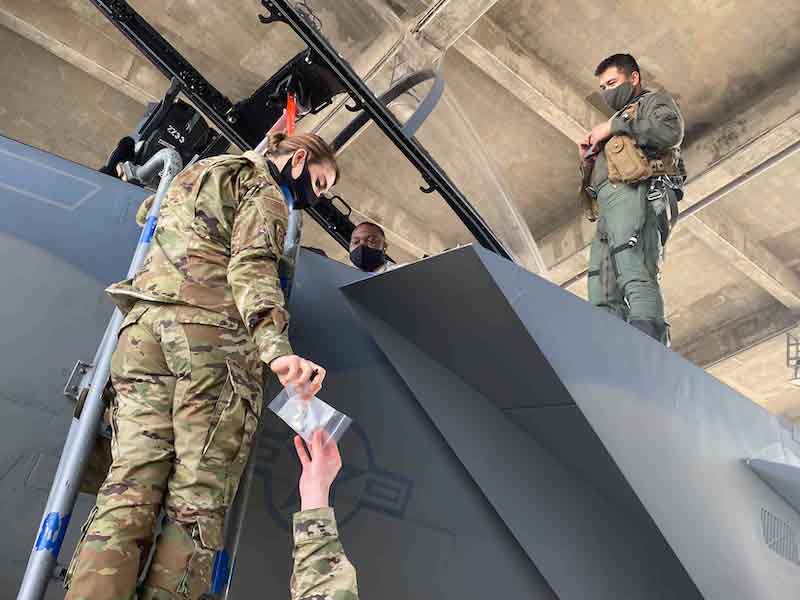KADENA AIR BASE, Japan — In 2020, the Air Force Medical Readiness Agency, began investigating whether there was possible exposure to carcinogens for personnel working with fighter jets, specifically to hexavalent chromium, a carcinogen created out of regular chromium.
As a consulting agency for all of the Pacific Air Force, the Theatre Prevention Medicine Flight out of the 18th Operational Medical Readiness Squadron, were tasked to assist with the research. They then turned to the Human Performance Optimization Flight and the Bioenvironmental Engineering Flight — their brother flights from the OMRS — to collect the samples needed for analyzing.
Regular chromium is often used in anti-corrosion paint, which is used by General Electric on some of the aircraft parts they provide to Kadena Air Base, explained 1st Lt. Madeleine Kallerud, the occupational health element chief for the Bioenvironmental Engineering Flight.
“Once it gets oxidized and reacts with calcium and magnesium that come from the engine, it creates this more hazardous part of hexavalent chromium, which is the concern,” she said. “Hexavalent chromium has been identified by the Occupational Safety Health Administration as being a potential carcinogen. There’s a potential contact and inhalation hazard over the course of eight hours.”
Air and Swipe Samples Utilized
 U.S. Air Force Capt. Christina Hall, a Human Performance Optimization Flight aerospace physiologist, displays her pre-flight gear at Kadena Air Base, Japan, Jan. 27, 2021. Hall volunteered to be the test subject in an investigation, looking into the potential exposure to carcinogens for personnel working with fighter jets. (Courtesy photo)The generation of hexavalent chromium in the engine begged the question of whether pilots were being exposed to it in the air or through contact inside the cockpit. Air and swipe samples were determined to be the best indicators of whether exposure was taking place and if present, how harmful it is. Samples were taken after a volunteer wore an air pump for eight hours and participated in a two hour flight.
U.S. Air Force Capt. Christina Hall, a Human Performance Optimization Flight aerospace physiologist, displays her pre-flight gear at Kadena Air Base, Japan, Jan. 27, 2021. Hall volunteered to be the test subject in an investigation, looking into the potential exposure to carcinogens for personnel working with fighter jets. (Courtesy photo)The generation of hexavalent chromium in the engine begged the question of whether pilots were being exposed to it in the air or through contact inside the cockpit. Air and swipe samples were determined to be the best indicators of whether exposure was taking place and if present, how harmful it is. Samples were taken after a volunteer wore an air pump for eight hours and participated in a two hour flight.
The volunteer, Capt. Christina Hall, an aerospace physiologist with the Human Performance Optimization Flight, came across the project by chance. She was temporarily displaced from her office due to construction and ended up working out of the TPMF building temporarily. While there, she was asked if she could arrange for a pilot to help with the project. Instead, she offered to gather the samples herself.
“I felt like it was better for me to fly with the air sample equipment as opposed to a pilot,” Hall said. “It is much safer for me to manage the air sample equipment because I am not physically operating the aircraft, and there are also very limited tasks that I may be required to do in flight, so managing the equipment wouldn’t affect my situational awareness to the extent that it would a pilot.”
Below Occupational Exposure Limits
The tests were conducted using a filter — on Hall’s lapel — that was attached to a pump. The pump was secured to her survival vest, and all extra components being added to her gear were flight-rated to ensure no hazards were presented.
The results have been found to be below the occupational exposure limit, supporting the results that GE gathered from their 80 different air and swipe samples, with all results coming back with negligible levels of exposure.
 Members of the 18th Operational Medical Readiness Squadron work alongside aircrew members to collect air and swipe samples from the cockpit of an F-15C Eagle at Kadena Air Base, Japan, Jan. 27, 2021. (Courtesy photo)While the testing and results can provide a sense of relief to Kadena, the research positively affects PACAF as a whole.
Members of the 18th Operational Medical Readiness Squadron work alongside aircrew members to collect air and swipe samples from the cockpit of an F-15C Eagle at Kadena Air Base, Japan, Jan. 27, 2021. (Courtesy photo)While the testing and results can provide a sense of relief to Kadena, the research positively affects PACAF as a whole.
“This sampling data that we collect here, is actually going to impact all other PACAF bases. And that’s going to go up to the AFMRA,” Kallerud said. “They can then come up with a strategy for all of the engine types across the Air Force. They’ll be over at Misawa, sitting in the backseat of the fighter, and know this is what we’re expecting to see for their exposure. They can validate that and take their own swipe samples to compare it to what we’ve collected here.”
Continued Testing on Other Airframes
Although the specific tests this time were done in F-15 cockpits, the continued testing on other airframes and the information gathered will help protect more than just pilots.
“It’s larger than just aircrew, it includes maintenance workers as well. The swipe testing tool will help determine if maintainers are at any risk,” Hall said. “From an aviator’s standpoint, if we can maintain our pilot health, that’d be a huge impact. But pilots can’t fly planes that aren’t fixed — if maintainers are dropping, then it doesn't matter how many pilots we have, we have no planes for them to fly. Preserving the lethality of our Air Force is dependent on the health of all those involved.”
Written by Airman 1st Class Cesar J. Navarro, 18th Wing Public Affairs. Originally published at https://www.kadena.af.mil/News/Article-Display/Article/2638219/reaching-across-flights-in-the-pursuit-of-safety/



































